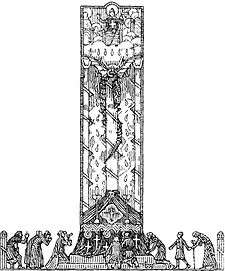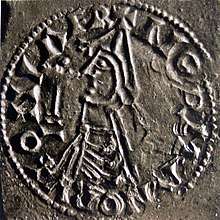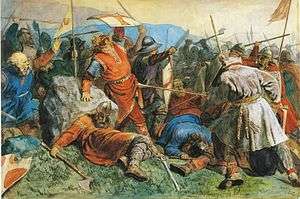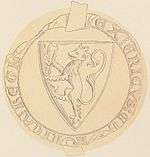Rex Perpetuus Norvegiae
Rex Perpetuus Norvegiae (Latin), i.e. Norway's Eternal King) is a term for King Olaf II of Norway, also known as Saint Olaf (Olav den hellige) .[1][2]

Illustration for Olav den helliges saga (1899)
Background
In written sources, the term Perpetuus rex Norvegiæ appears from the second half of the 12th century in Historia Norvegiæ.[3]
Olaf's great-nephew, King Magnus III of Norway and of Mann and the Isles, reportedly was the first king known to use the Norwegian lion in his standard although Snorri Sturluson is the only source for this. The first instance of the lion bearing an axe is found in a seal of King Eric II of Norway (1285). The axe represents Olaf II as 'martyr and saint'.[4] [5]
Gallery
 Silver coin of King Olav II (ca. 1023–28)
Silver coin of King Olav II (ca. 1023–28)- Sant'Olav II, Re di Norvegia in San Carlo al Corso by Pius Weloński (1893)
 Olav den Helliges død by Peter Nicolai Arbo (ca. 1859)
Olav den Helliges død by Peter Nicolai Arbo (ca. 1859) Statue of Saint Olaf exhibited in University Museum of Bergen (ca. 1400)
Statue of Saint Olaf exhibited in University Museum of Bergen (ca. 1400)- Head of a crosier from Norway showing St Olaf with his axe. Victoria and Albert Museum. (1375-1400)
 Seal of King Eric II of Norway (1285)
Seal of King Eric II of Norway (1285) Norwegian coat of arms (Standardised variant from 1992)
Norwegian coat of arms (Standardised variant from 1992)
gollark: So the universe's magic anti-paradox feature is forced to calculate it for you, or this generates some sort of really unlikely failure mode in your computing system.
gollark: 1. receive message from future containing the answer to your problem2. check it (this assumes it's one of the easy-to-check hard-to-answer ones)3. send it back
gollark: You can use informational time travel plus the fixed-timeline thing for hypercomputing, which is neat.
gollark: What I think a lot of settings do is have it so that you can transmit information to the past, but you can't edit history at all - what happened to cause the information to be sent, still happens. It's very confusing and can also be used for computation.
gollark: Er, future→past, I mean.
References
- Claus Krag. "Olav 2 Haraldsson Den Hellige". Norsk biografisk leksikon. Retrieved July 15, 2016.
- "Olaf of Norway". OrthodoxWiki. Retrieved July 15, 2016.
- "Historia Norvegiæ". Retrieved 23 May 2016.
- Leif Inge Ree Petersen. "Olav den hellige". Store norske leksikon. Retrieved July 15, 2016.
- "The National arms of Norway". Heraldry of the World. Retrieved July 15, 2016.
This article is issued from Wikipedia. The text is licensed under Creative Commons - Attribution - Sharealike. Additional terms may apply for the media files.